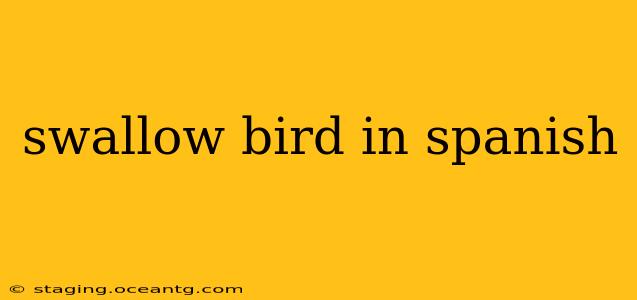The English word "swallow" refers to several species of birds in the Hirundinidae family. Therefore, a direct translation into Spanish isn't always straightforward, as the specific Spanish term will depend on the type of swallow you're referring to. However, the most common and widely understood translation is golondrina.
What is the most common Spanish word for swallow?
The most common and widely accepted Spanish word for swallow is golondrina. This term is understood throughout most Spanish-speaking regions and encompasses many of the common swallow species. If you're unsure of the exact species, using "golondrina" is generally safe.
Are there other Spanish words for swallows?
While golondrina is the most prevalent, regional variations and more specific names exist depending on the particular swallow species. For instance, some regions might use terms like:
-
Avión: This term is sometimes used, particularly in certain parts of Spain, and can refer to specific swallow species or even other similar-looking birds. It's less common than "golondrina" and could lead to confusion.
-
Golondrilla: This is a diminutive of "golondrina," meaning "little swallow," and might be used to refer to smaller swallow species.
Using "golondrina" remains the safest and most widely understood option for general use.
What about different types of swallows? How do I specify?
If you need to be more precise, you'll need to specify the type of swallow. Unfortunately, a direct translation doesn't always exist. For example, there's no single perfect Spanish equivalent for a "barn swallow" or a "cliff swallow." To clarify, you might use a descriptive phrase, like:
- Golondrina parda: (Brown Swallow) - This could be used to describe a barn swallow.
- Golondrina de ribera: (River Swallow) - This could refer to a swallow that nests near water.
- Golondrina común: (Common Swallow) - This is a general term that indicates a common or frequently seen swallow.
Always try to provide more context when possible to ensure accurate communication. A picture, for example, would eliminate any ambiguity.
How do you say "swallow" as in the act of swallowing?
It's important to note that the word "swallow" can also refer to the act of swallowing something. In Spanish, this is tragar. This word has no relation to the bird. Context is key in distinguishing these two distinct meanings.
What are some common phrases using "golondrina"?
- "Como una golondrina:" (Like a swallow) - This is used to describe someone or something that moves quickly and gracefully.
- "Volar como una golondrina:" (To fly like a swallow) - This describes graceful and swift flight.
Understanding the nuances of language is essential for clear communication. While "golondrina" serves as the primary translation for "swallow," being aware of regional variations and the possibility of using descriptive phrases enhances accuracy. Remember to consider the context to ensure your message is understood correctly.
